Diplomatic Bluebook 2018
Chapter 2
Japan's Foreign Policy that Takes a Panoramic Perspective of the World Map
2 Central Asian and Caucasian Countries
(1)Central Asian Countries
Japan is supporting the “open, stable and self-sustained development” of Central Asia, which is geopolitically important and is promoting the development-support diplomacy with the objective of contributing to the peace and stability of the region. The three pillars of Japan's diplomacy in Central Asia are as follows; (1) fundamental strengthening of bilateral relationships; (2) encouragement of regional cooperation and contribution to the common issues of the region through the “Central Asia plus Japan” Dialogue; and (3) cooperation in the global arena.
In 2017, Japan and five Central Asian countries celebrated the 25th anniversary of the start of diplomatic relations and following similar efforts in the previous year, active exchanges including VIP visits were carried out. From Central Asian countries, Foreign Minister of Kyrgyz Republic Abdyldayev visited Japan in March, Minister of the Economic Development and Trade of Tajikistan Khikmatullozoda visited in April, and Deputy Chairman of the Cabinet of Ministers and Minister of Foreign Affairs of Turkmenistan Meredov visited in June. In terms of political party exchanges, First Deputy Chairman Kul-Mukhammed of the Nur-Otan Party of the Republic of Kazakhstan visited Japan in May.
From Japan for the first time of a sitting Foreign Minister of Japan, Foreign Minister Kishida visited Turkmenistan in May. During his visit, the Sixth Foreign Ministers' Meeting of the “Central Asia plus Japan” Dialogue was held in the capital of Turkmenistan, with attendance of Foreign Ministers from five Central Asian countries. From June to September, Astana World EXPO was held in the capital of Kazakhstan, Astana, under the theme of “Future Energy,” and was attended by a variety of key figures from Japan, such as Minister of Economy, Trade and Industry Seko, State Minister for Foreign Affairs Nakane, State Minister of Economy, Trade and Industry Kosaburo Nishime, State Minister of Economy, Trade and Industry Yoji Muto, Parliamentary Vice-Minister of Economy, Trade and Industry Daisaku Hiraki, and Parliamentary Vice-Minister of Defense Takayuki Kobayashi. In September and November, Parliamentary Vice-Minister for Foreign Affairs Manabu Horii repeatedly visited Turkmenistan to attend the 5th Asian Indoor and Martial Arts Games as well as the Energy Charter Conference respectively. Additionally, the Central Asia Cultural Exchange Mission7 visited Turkmenistan in April, and Tajikistan, Kyrgyz Republic, and Kazakhstan in November.
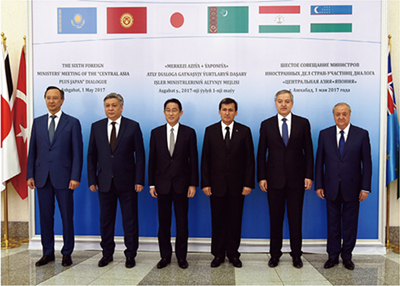 Sixth Foreign Ministers' Meeting of the “Central Asia plus Japan” Dialogue (May 1, Ashgabat, Turkmenistan)
Sixth Foreign Ministers' Meeting of the “Central Asia plus Japan” Dialogue (May 1, Ashgabat, Turkmenistan)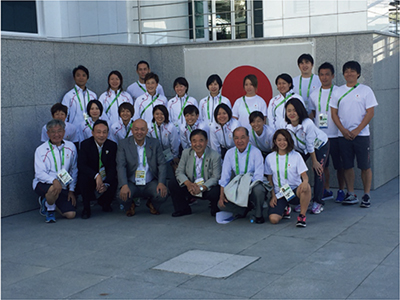 Parliamentary Vice-Minister for Foreign Affairs Manabu Horii encouraging Japan's national team ahead of the 5th Asian Indoor and Martial Arts Games (September 16. Ashgabat, Turkmenistan)
Parliamentary Vice-Minister for Foreign Affairs Manabu Horii encouraging Japan's national team ahead of the 5th Asian Indoor and Martial Arts Games (September 16. Ashgabat, Turkmenistan)In the framework of the “Central Asia plus Japan” Dialogue, business dialogue was held in February, where more than 100 representatives from Japanese companies and economic organizations who took part in discussions aiming at developing economic relationships between Japan and Central Asian countries. In August, the 10th Tokyo Dialogue (intellectual dialogue) was held under the theme “the present and the future of Japan-Central Asia relations.” Cultural exchange events were also held to share the attractiveness of Central Asia. These included an exhibition of the original illustrations from the comic “A Bride's Story (Otoyome Gatari),” the release of cooking videos of Central Asian cuisine, and the Manga “Let's Make It With Everyone! Central Asian Cooking” newly drawn by comic artist Kaoru Mori (See Column “Sharing the Attractiveness of Central Asia - Starting with Comics and Cuisine for a Milestone Year”).
In Turkmenistan, a presidential election was held in February after the expiration of the President's term of office and resulted in the re-election of the incumbent President, Berdimuhamedov. In the Kyrgyz Republic, a presidential election was held in October with the expiration of the president's term of office and previous Prime Minister Jeenbekov was elected as a President in November. For this election, biometric data registration machines and readers provided by Japan were used, and the election observation mission was dispatched from Japan.
- 7 As a follow-up of the visit by Prime Minister Abe to all of the Central Asian countries in October 2015, the Japan Foundation (JF) has designated Central Asia as one of its “priority regions” and is intensively planning and implementing cultural exchange projects in a wide range of areas in this region. As a part of this, it dispatched the Japan Foundation Central Asia Cultural Mission, a cultural exchange delegation comprising experts in a variety of fields including culture and arts, to five Central Asian countries. The first delegation was dispatched in August 2016 (Uzbekistan), the second delegation was dispatched in April 2017 (Turkmenistan), and the third delegation was dispatched in November of the same year (Tajikistan, Kyrgyz Republic, and Kazakhstan), studying each delegates made site-visit of cultural and community projects in five Central Asian countries and exchanged views and information with experts. The report of these delegations was submitted to Prime Minister Abe in December of the same year.
(2) Caucasus countries
The relations between Japan and Caucasus countries were further strengthened through high-level mutual visits as well.
From Georgia, which shares with Japan fundamental values of liberty, democracy and the rule of law and seeks integration into Europe, First Vice Prime Minister of Economy and Sustainable Development Kumsishvili visited Japan in May to attend the annual meeting of the Asian Development Bank (ADB), and Vice Prime Minister of Foreign Affairs Janelidze visited Japan from May to June and met Foreign Minister Kishida. Additionally, State Minister for Reconciliation and Civic Equality Tsikhelashvili visited Japan in September. From the Japanese side, State Minister of Land, Infrastructure, Transport and Tourism Ryosei Tanaka visited Georgia in January and Parliamentary Vice-Minister for Foreign Affairs Takisawa also visited the country in June, where they met with high-level Government officials.
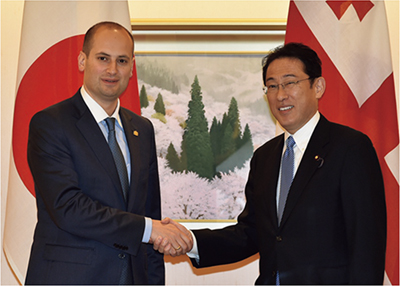 Japan-Georgia Foreign Ministers' Meeting (June 2, Tokyo)
Japan-Georgia Foreign Ministers' Meeting (June 2, Tokyo)With abundant natural resources, Azerbaijan leads the economy of the Caucasus area. From Azerbaijan, Finance Minister Sharifov visited Japan in May to attend the annual meeting of the ADB, and Deputy Minister of Foreign Affairs Khalafov visited in November. From the Japanese side, State Minister of Economy, Trade and Industry Yoshifumi Matsumura visited Azerbaijan in February, so did Parliamentary Vice-Minister for Foreign Affairs Manabu Horii in September, Vice- Minister Horii met high-level Government officials including President Aliyev and First Vice President Aliyeva. He also attended the signing ceremony for the extension of the production sharing agreement (PSA) for the development of Azeri-Chirag-Gunashli (ACG) oil field, in which Japanese companies participate.
From Armenia, which is rich in human resources, especially in the IT field, President of the National Assembly Sahakyan visited Japan in January on the invitation of the House of Representatives. President Sahakyan made a courtesy call to Prime Minister Abe and had a meeting with the Speakers of both Houses of the Diet. From the Japanese side, Parliamentary Vice-Minister for Foreign Affairs Takisawa visited Armenia in June, and met with high-level Government officials including President Sahakyan and Foreign Minister Nalbandian. Armenia held an election for its National Assembly in April and the ruling Republic Party of Armenia maintained the largest number of seats and its status as the ruling party.
Meanwhile, in Caucasus countries, there still exist disputes including South Ossetia and Abkhazia8 in Georgia, and the Nagorno-Karabakh Conflict9 between Armenia and Azerbaijan, both which still cause tensions among the countries involved. Although efforts toward resolution have been made, no specific progress has been seen (as of February 2018).
- 8 In August 2008, an armed conflict took place between Georgia and South Ossetia; the latter was aiming for separation and independence from the former. Russia intervened in the dispute which led to a military conflict between Georgia and Russia. About one week after the conflict occurred, France, which was then EU president, and other states acted as mediators and realized a cease-fire. Based on the agreement reached at that time, international conferences have been held in Geneva to discuss security and humanitarian issues among parties concerned.
- 9 This is a dispute between Armenia and Azerbaijan regarding Nagorno-Karabakh. Most of the residents living in the disputed Nagorno Karabakh area are Armenian and during the Soviet era they made increasingly strong demands to change their affiliation from Azerbaijan to Armenia and this led to a dispute between the two countries following the dissolution of the Soviet Union in 1991. Armenia had occupied almost the entire region of Nagorno-Karabakh and the surrounding seven areas by 1993. In 1994, the two countries agreed to a cease-fire through the intermediation of Russia and the OSCE; however, conflict with casualties has been repeated until now. In April 2016, the largest military clashes since the cease-fire in 1994 occurred and a few days later both parties agreed to a cease-fire. Since 1999, an intermediation of the OSCE Minsk group has allowed direct talks between Armenia and Azerbaijan at various levels, including their leaders and foreign ministers, but there is still no prospect of a resolution (as of February 2018).
1. 25th Anniversary of the Establishment of Diplomatic Relations between Japan and Central Asian countries
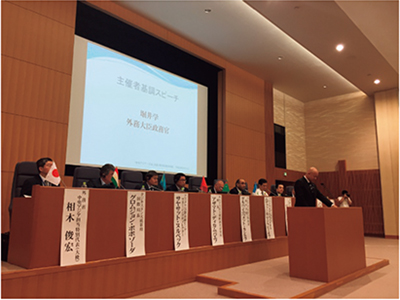 Keynote speech by Parliamentary Vice-Minister for Foreign Affairs Manabu Horii at the 10th Tokyo Dialogue (August 31, MOFA, Tokyo)
Keynote speech by Parliamentary Vice-Minister for Foreign Affairs Manabu Horii at the 10th Tokyo Dialogue (August 31, MOFA, Tokyo)2017 marked the 25th anniversary of the establishment of diplomatic relations between Japan and Central Asian countries. Japan has promoted friendly and cooperative relationship with Central Asian countries through providing economic assistance for nation building and support in a wide range of fields. While the Central Asian region is not quite familiar to Japanese people, it has been recently attracting attention as the area of geographical importance and a new destination for investments.
2. The Central Asia plus Japan Dialogue / The 10th Tokyo Dialogue
The Tokyo Dialogue is a public symposium held as part of the framework of “Central Asia plus Japan” Dialogue, which was launched by Japan in 2004. The 10th Symposium entitled “Thinking of the present and future of relations between the Central Asia and Japan,” was held this year and active exchanges of ideas were made there.
3. The 10th Tokyo Dialogue Side Event: Exhibition of Original Illustrations, Cooking Videos, Comic Streaming
Along with the Tokyo Dialogue, MOFA conducted three cultural programs.
The first was the exhibition of original illustrations of the comic “A Bride's Story (Otoyome Gatari)” set in Central Asia in the 19th century, which was drawn by Ms. Kaoru Mori. The popularity of Kaoru Mori and novelty of the event as the first exhibition of original illustrations organized by the Ministry of Foreign Affairs, made it big news, followed with very positive comments on social network sites, such as “Really thank you! MOFA!” and “Impressive! MOFA has gone this far, thank you!”
The second event was the release of cooking videos of Central Asian cuisine. These videos were made and released with the aim of enhancing the public's knowledge of Central Asian cuisine that are not familiar to Japanese people but can be easily made at home (plov, dimlama, lagman) (available for viewing on the Ministry of Foreign Affair's official website: http://www.mofa.go.jp/mofaj/erp/ca_c/page23_002183.html).
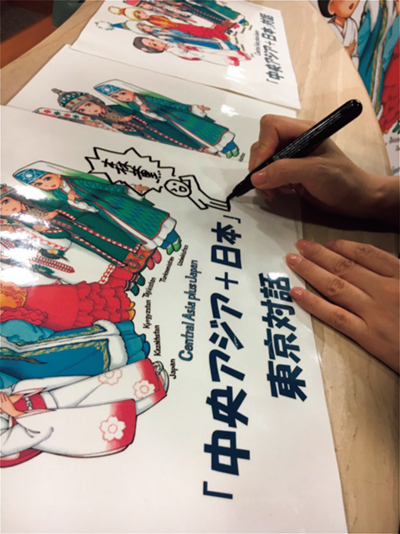 Ms. Kaoru Mori attending the Exhibit of Original illustrations (August 29, MOFA, Tokyo)
Ms. Kaoru Mori attending the Exhibit of Original illustrations (August 29, MOFA, Tokyo)The third program was the publishing of the Manga “Central Asia Cooking (seven stories in total)” newly drawn by Kaoru Mori exclusively for this project. Characters representing respective Central Asian Countries, who had painted on the body of the Government Aircraft at the occasion of Prime Minister Abe's official visit to Central Asia in 2015, this time introduced Central Asian cuisines in this comic (available for viewing on the Ministry of Foreign Affair's official website: http://www.mofa.go.jp/mofaj/erp/ca_c/page24_000897.html). This section of the Foreign Ministry's website is so popular that it recorded the highest number of visits in the entire website of MOFA. It was also featured on social networking sites as well as news websites, and made a gateway to Central Asian countries for many Japanese people. While it has not been officially charted in the Japanese Vogue Words Award yet, the fans of the comic are starting to use the phrase “otsukare-stan” (coined phrase meaning “See you later!”).
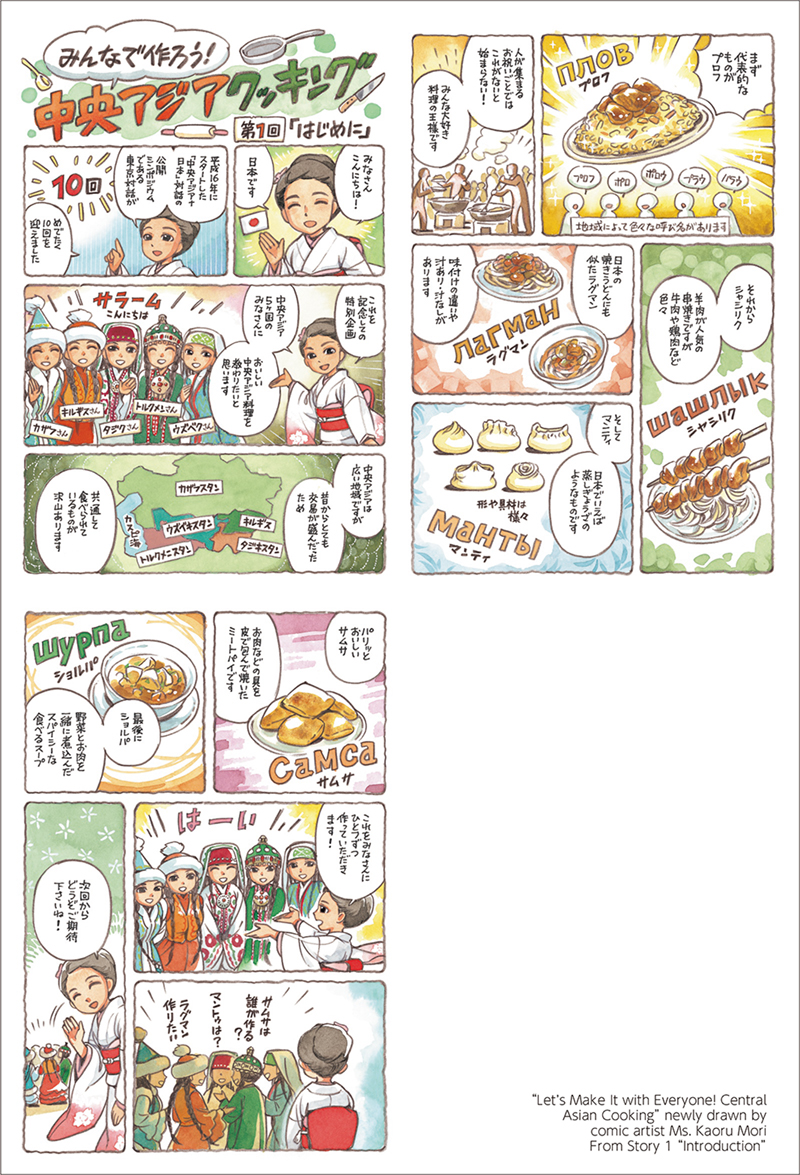 “Let's Make It with Everyone! Central Asian Cooking” newly drawn by comic artist Ms. Kaoru Mori From Story 1 “Introduction”
“Let's Make It with Everyone! Central Asian Cooking” newly drawn by comic artist Ms. Kaoru Mori From Story 1 “Introduction”
